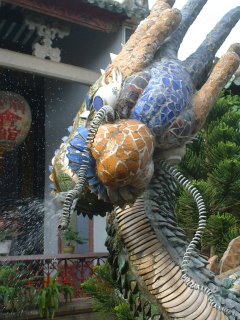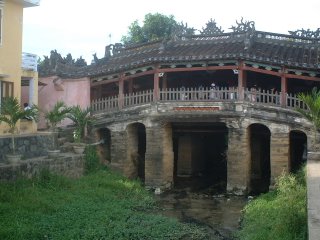A-Hoi An










Hello Faithful Readers:
I'm in Hoi An, not far from Hue, where I last wrote, so this will be an shortish update.
My last day in Hue was spent cycling out into the countryside in search of some imperial tombs from the 19th-century Nguyen Dynasty. It was a lovely day, if a bit hot, and I really liked the excursion. My first tomb, Gia Long, which took absolutely forever to find as it's off the tourist trail, the beaten track and even the dirt road. When I finally got there, though, it was love at first sight. A couple of water buffaloes and their minder were my only company. The tomb complex, a series of red-brick pavilions and pillars and enclosures, was in ruins. Very atmospheric ruins. I love overgrown, deserted ruins, and these were what I was looking for. The Nguyen Emperors liked their tombs to be surrounded by water, so there were ponds thick with water lilies and lotuses. There were wildflowers growing through and over the stairs of the memorial temple, and two huge pillars stuck their heads up through the surrounding forest. It reminded me a bit of Sri Satchanalai in Thailand, although, given its recent date, a better parallel would be Ayutthaya. In December I had a look at some of the Ming Imperial tombs outside Beijing, and I much preferred this one; a more human scale, less overwhelming bombast, and the key ingredient of water.
I bumped, ferried and pedalled my way back to the main road and had a good look at Ming Manh and Thieu Tri. Ming Manh was in much better shape than Gia Long, and it gave me a better idea what Gia Long must once have looked like. There were a few tourists, but at times I had the whole beautiful, graceful, harmoniously laid-out complex to myself. The actual grave of Ming Manh was at the back of the complex, underneath a sizeable tumulus of earth overgrown with pine trees. This is exactly the same as the tombs of the Tang and Han emperors outside Xian in China. Apparently the 200 servants who buried the body were all beheaded afterwards to make it more difficult for grave-robbers to find the exact location of the corpse. The amazing thing to me is that this is not something that happened 3000 years ago (the Egyptian Pharaohs played the same trick on their grave-diggers), but rather 160 years ago. This is the sort of behaviour that causes revolutions amongst the people. Thieu Tri was more like Gia Long, and I pottered about happily for an hour or so among the ruins.
That evening, to my great delight, a local camera repair shop fixed my digital camera. When he unscrewed the camera body, a piece of metal fell out, which is never a good sign. I had been contemplating disassembling the thing myself, but when I saw how complex the wiring was inside, I was glad that I hadn't. $10 very well spent, I think.
The next day I got up, had a final enormous traveller's breakfast (musli with fruit and yoghurt, banana pancakes and fruit shakes) and hit the road. It was a sizzling hot day, and I had a big climb in front of me into the coastal mountains and Bach Ma National Park. I got to the bottom around 11, dreading the heat of the climb, but I was saved by the stupidity of park regulations. "No bicycles or motorcycles allowed on the road into the park!" I was told. When I asked why, I was told that it was too steep and dangerous, and would I like to rent a jeep for $25 to ride up. I pointed out that surely a bicycle was environmentally friendlier and less likely to scare the animals and birds, but logic will never get you anywhere in the face of otiose bureaucracy. I decided that if the park management were that dense, I didn't want to give them my money, and I cycled away in annoyance.
About an hour later, a little boy walked to the far side of the road as I was passing, waited carefully for traffic coming both ways to be clear, and threw a handful of rocks at me. Luckily his aim was poor, and the few pebbles that didn't miss me entirely rattled harmlessly off my spokes. However, of all the obnoxious things that little (and not so little) boys do to me on my travels, throwing stones is by far my least favourite. In Pakistan and Tibet I was regularly pelted with stones, and I hate it. It's so unfriendly, dangerous and unnecessary. Unfortunately for this little Vietnamese boy, the gap in traffic made it easy for me to wheel around and give chase, which he had not counted on. I pursued him down a little road and he darted into a yard and was gone. As I returned to the highway, though, I spotted him hiding close to the scene of the crime. I put my bike down and ran after him, and this time, since I was on foot, it was hard for him to escape. I was yelling at him, and he was shrieking in what seemed to be genuine fright. At last I caught up to him in a little tea shop next door, and the look of pure terror on his face as he hid behind the adults made my day entirely. Without having actually to hit him, I was able (I hope) to put sufficient fear of God (or at least of avenging foreign cyclists) into him that he will never again throw rocks at passing tourists on bikes. I cycled away happy at having done my good deed for the day.
My smiles were increased by my next two detours from the main road. First up was Suoi Voi, a lovely series of swimming holes in a cold mountain river. Huge boulders separate the pools and provide privacy and peace, and my overheated body was glad to soak in the cool water for a while. Shortly after that, I found my way to Lang Co, a thin sandbar peninsula separating the South China Sea from an inland lagoon. On the uninhabited northern stretch of the beach, I swam and bodysurfed and read my Louis de Bernieres book and swam some more. When I rolled into the main tourist town area of Lang Co, I was glad I had swum where I had. Lang Co was a busy strip of hotels , all of which were full, or at least the first 10 I asked at. I finally found the last room in town, a concrete sweatbox, had a meal of crab (I ordered clams, but apparently the English menu got mixed up between the two) and tossed and turned all night in the heat on my rock-hard tiny bed, listening to passing trucks blasting their air horns.
Yesterday I awoke a bit groggy. "Lang Co is so quiet, isn't it?" asked the woman who ran the hotel. "Quieter than what? An atomic bomb?" It really was one of the most remarkably noisy places of the whole trip. I started the day with a couple of peanut butter baguettes (baguette sandwich stalls seem to be everywhere now, to my delight; I hardly saw any in the north) before tackling the pretty Hai Van Pass. It took 54 minutes (yes, I counted) to sweat my way to the top, 450 metres above sea level), where I had great views back to Lang Co (everything looks more beautiful from far above, I find) and ahead to Da Nang. The descent was wonderful, and I sped into bustling Da Nang.
The only thing I did in Vietnam's fourth city was to go to the Cham Museum. The Cham empire, originally centred around Da Nang, was a contemporary of Angkor, and, like its more famous neighbour, was a Hindu state that looked to India for cultural influences. There were lots of worn, weathered statues of Vishnu and Shiva, and I spent a couple of hours taking pictures and trying to sketch a few statues. I'm really looking forward to seeing some of the major Cham temple ruins over the next week or so as I head south.
I sped out of town to China Beach, a favourite RnR site for US troops 40 years ago, where I had the best meal of my trip so far in a seafood restaurant overlooking the South China Sea, and then relaxed on a deserted strip of beach for a couple of hours. During the second hour, a Vietnamese teenager came up to where I was lying and sat there, staring at me, watching me read. His capacity to withstand boredom was phenomenal. I finally got up and left, and he remained, gazing at me, until I had vanished around the next bend in the road.
The ride along the beach road to Hoi An was pure misery, through endless potholes, construction and dust. It was worth it, though. Hoi An is lovely, an oasis of history and architecture in the cultural desert that is most of modern Vietnam. I spent today happily wandering the old streets, poking around old Chinese merchants' houses, relics of when Hoi An was the major international port of Vietnam from 1600-1850. Now, like Venice, it basks in the warmth of its bygone glory and packs in the tourists. I think I will spend another couple of days here, lounging in the best hotel of the trip so far. I slept so well last night that I don't really want to leave my enormous bed and cool, dark bedroom. Tomorrow a visit to My Son, a major Cham site, is on the books.
Until next time,
Tam Biet!
Graydon

0 Comments:
Post a Comment
<< Home